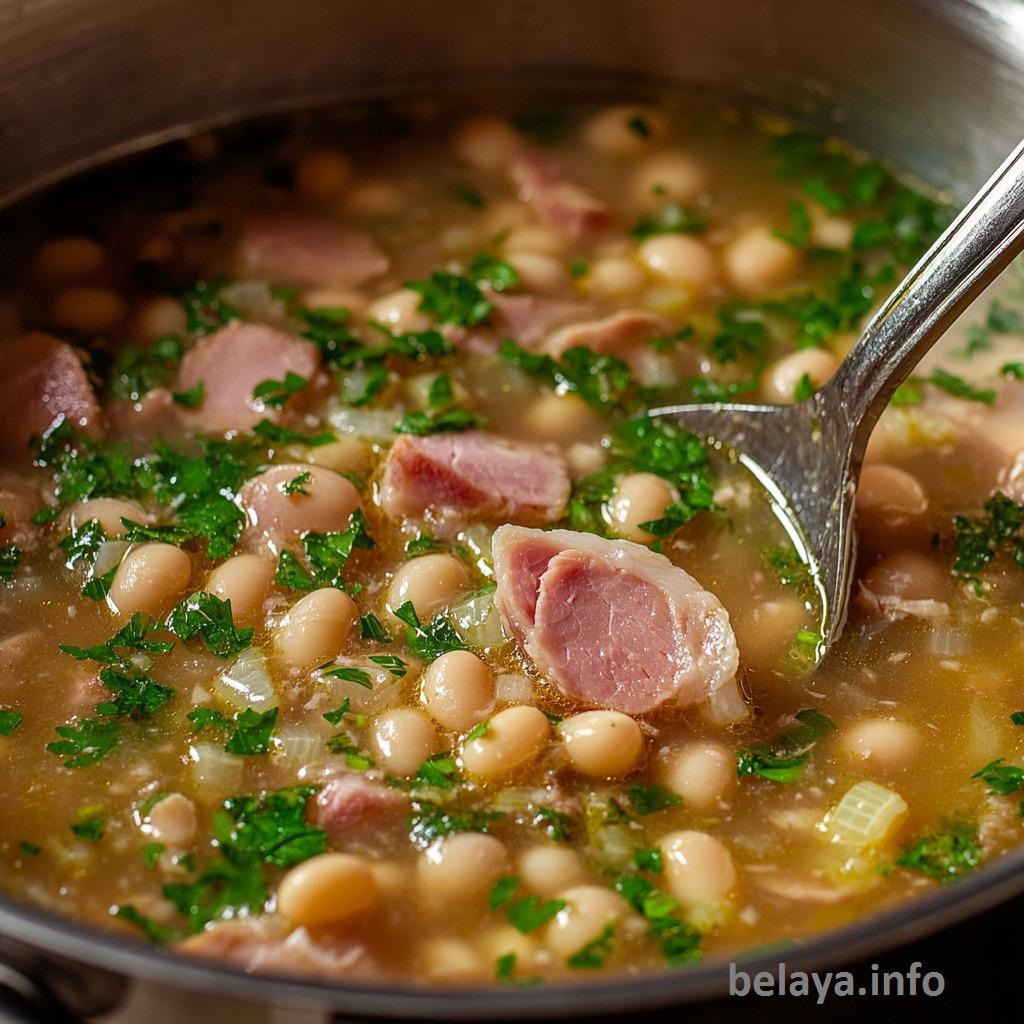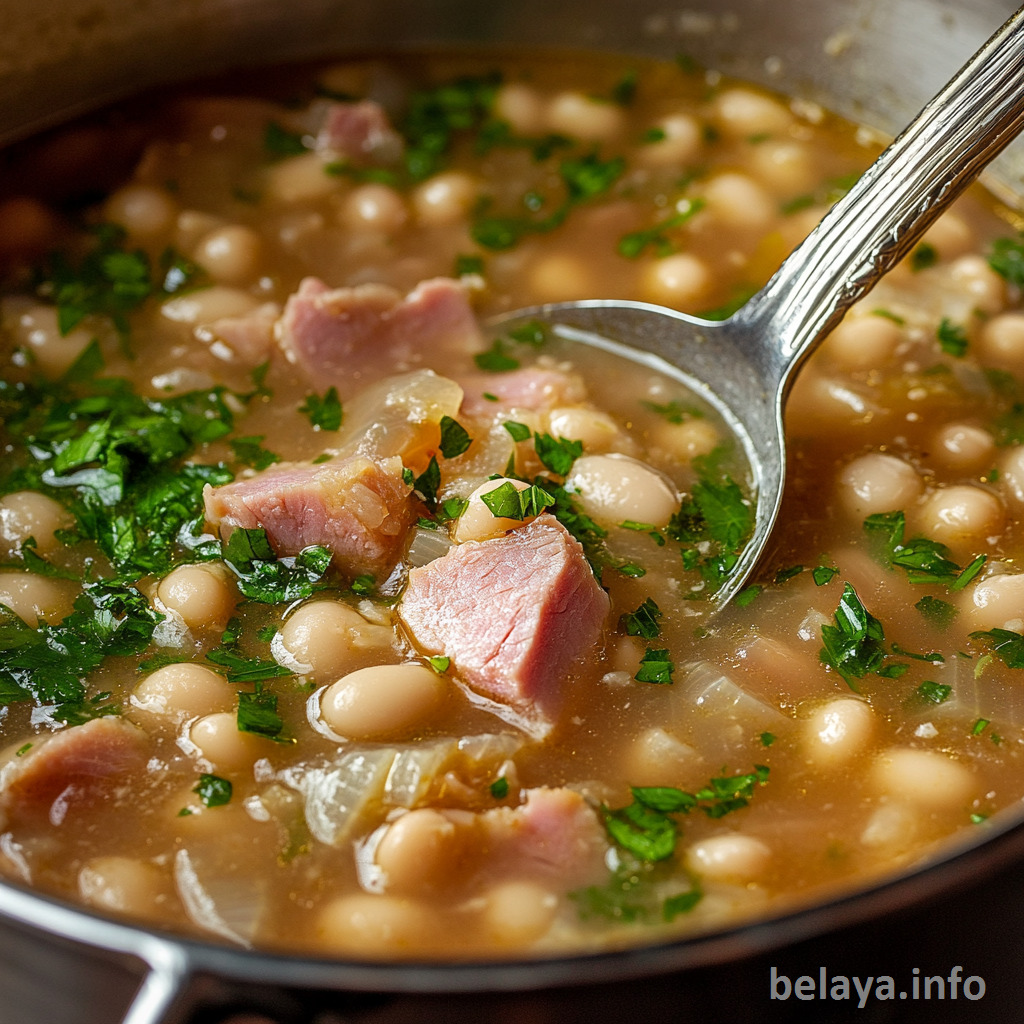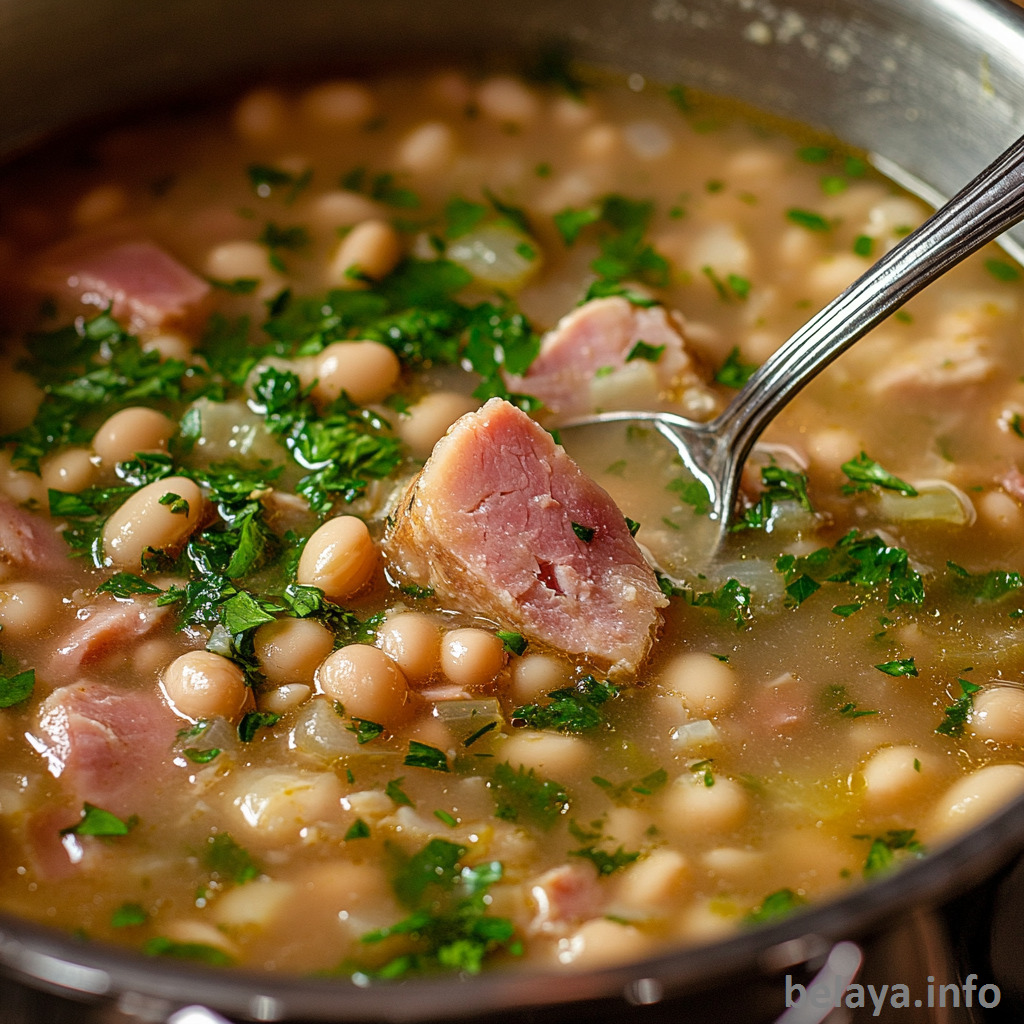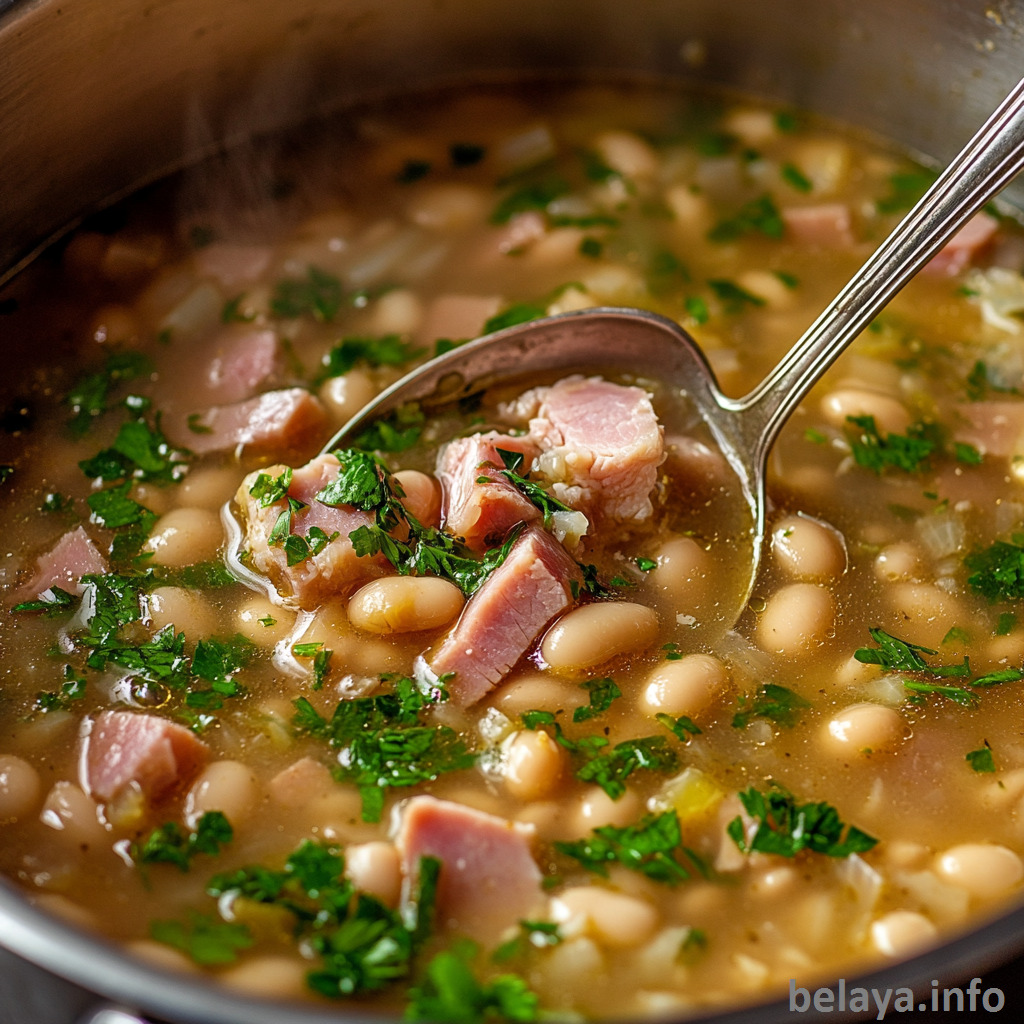White Bean & Ham Hock Soup
White Bean & Ham Hock Soup is a timeless, soul-warming dish that brings comfort and depth with every spoonful. Rooted in tradition, this rustic recipe transforms simple, pantry-friendly ingredients into a deeply flavorful meal through slow simmering and patient layering.
The smoky richness of ham hocks infuses the broth, while creamy white beans absorb every note of savoriness. Aromatic vegetables and herbs build complexity, and a final touch of Tabasco adds gentle heat.
It’s the kind of soup that nourishes beyond hunger—perfect for cold evenings, leftover ham, or when you simply need something honest and grounding.

Why People Will Love This White Bean & Ham Hock Soup Recipe:
Slow-simmered comfort with depth: The long, gentle simmer of ham hocks creates a rich, smoky broth that infuses every bite with soul-warming flavor—deep, savory, and satisfying.
Protein-packed and nourishing: White beans and ham together offer a hearty, balanced mix of protein and fiber, making this soup not only filling but nutritionally grounding.
Rustic simplicity with layered flavor: A humble blend of beans, vegetables, and herbs becomes something extraordinary through time and technique, showcasing how modest ingredients can yield complex results.
Versatile and forgiving: This soup adapts well—use leftover ham, vary the beans, or tweak the seasoning to suit your taste. It’s a flexible, make-it-your-own recipe that invites personal touches.
Ideal for batch cooking and leftovers: It stores and reheats beautifully, with flavors improving over time. Perfect for meal prep, freezing, or feeding a crowd on a cold night.
A nostalgic, homemade feel: For many, it evokes memories of family kitchens, slow-cooked Sundays, and shared meals—creating a comforting connection between food and feeling.

Key Ingredients:
White beans (such as cannellini or Great Northern) form the hearty, creamy backbone of the soup. Their mild flavor absorbs the smoky, savory broth beautifully, while their high fiber and protein content make the dish deeply nourishing.
Smoked ham hocks or shanks bring a rich, meaty depth and a signature smokiness that defines the soul of the soup. As they simmer, they release collagen, flavor, and tenderness, turning simple broth into a layered, full-bodied base.
Aromatics—onions, garlic, celery, and carrots— build the foundational flavor. The sweet sharpness of onion, the earthy base of celery, the subtle sweetness of carrot, and the bold punch of garlic combine to enhance the broth without overpowering the ham.
Herbes de Provence or Italian seasoning infuse the soup with herbal complexity—typically a blend of thyme, rosemary, oregano, and marjoram. These herbs elevate the rustic profile and add gentle floral and woodsy undertones.
Tabasco sauce adds more than heat—it introduces a bright, acidic finish that cuts through the richness of the ham and beans, keeping the soup vibrant and balanced.

Expert Tips:
Use meaty ham hocks or shanks for depth and body: Choose hocks with plenty of visible meat. As they simmer, the connective tissue and marrow infuse the broth with gelatin, giving it a naturally silky texture and rich mouthfeel.
Soak the beans properly—but avoid over-soaking: A 2-hour quick soak softens the beans without making them mushy. Over-soaking can cause the beans to break down too quickly during simmering, leading to a thinner texture.
Sauté aromatics separately before adding to the soup: Lightly caramelizing the onions and garlic in olive oil before adding them to the pot enhances sweetness and adds layers of complexity that raw simmering alone won’t achieve.
Simmer uncovered for better concentration: Cooking the soup uncovered allows some of the liquid to evaporate, concentrating the flavors and thickening the broth naturally—especially important when you want depth without needing cream or thickeners.
Shred ham off the bone carefully and discard excess fat or gristle: Once tender, remove the hocks and separate the lean meat with tongs or a fork. Discard skin, fat, and bone to maintain a clean, velvety soup texture.
Add acidity and heat at the end, not during simmering: Stirring in Tabasco or a splash of vinegar right before serving brightens the entire dish and balances its richness. Doing this too early can mute the acid’s impact.
Let it rest before serving: Like many bean-based soups, this dish tastes even better after resting for 30 minutes—or even the next day. The beans continue to absorb flavor, and the broth deepens in character.
White Bean & Ham Hock Soup
Ingredients
1 pound (about 2½ cups) dried white beans — such as cannellini or Great Northern
2 quarts (8 cups) water
2 to 3 pounds of smoked ham hocks or ham shanks
2 teaspoons dried Herbes de Provence or Italian herb blend
1 tablespoon extra-virgin olive oil
1 small onion, finely diced (about 1 cup)
2 to 3 celery stalks, chopped (approximately 1 cup)
1 medium carrot, peeled and chopped (about ⅔ cup)
2 to 3 cloves fresh garlic, minced
A few dashes of Tabasco or your favorite hot sauce (to taste)
Sea salt and freshly ground black pepper, to taste
Fresh chopped parsley, for garnish
Instructions:
Soak the Beans
Bring a large pot of water to a boil.
Remove from heat, stir in the dry white beans, and let them soak for about 2 hours.
After soaking, drain and set the beans aside.
Prepare the Ham Broth
While the beans are soaking, place the ham hocks or shanks in a large stockpot.
Cover with 2 quarts of water and add the Herbes de Provence or Italian seasoning.
Bring to a gentle simmer over high heat, then reduce to low.
Partially cover and simmer for 1 hour to build a rich, smoky broth.
Sauté the Aromatics
In a small skillet, heat the olive oil over medium heat.
Add the diced onions and sauté for 5–6 minutes, until softened and translucent.
Stir in the minced garlic and cook for 1 more minute until fragrant.
Add Beans and Vegetables to the Broth
After the ham has simmered for an hour, stir in the drained beans, sautéed onions and garlic, chopped celery, and carrots.
Simmer the soup uncovered for another 40 minutes, or until the beans are tender and the ham is falling off the bone.
Shred the Ham and Finish the Soup
Remove the ham hocks from the pot.
Shred the meat from the bones and return it to the soup.
Discard the bones.
Season and Serve
Adjust the seasoning with salt, pepper, and a few dashes of Tabasco for a touch of heat.
Ladle into bowls and garnish with fresh chopped parsley.
Serve hot with crusty bread.

Important Notes When Making White Bean & Ham Hock Soup:
Bean texture is crucial: Use dried beans for the best texture and flavor. Canned beans won’t absorb the broth as effectively and may turn mushy during the long simmer. Soaked dried beans become creamy yet hold their shape—perfect for this rustic soup.
The quality of ham hocks matters: Opt for high-quality, naturally smoked ham hocks or shanks. Avoid overly processed versions, as they may introduce artificial flavors or excessive saltiness, which can throw off the balance of the soup.
Salt should be added carefully and late: Because ham hocks are naturally salty, it’s best to wait until the very end to add additional salt. Taste the broth once it’s fully developed and seasoned by the ham before adjusting.
Simmering time isn’t rigid—watch the beans and meat: Depending on the age of your beans or the size of the hocks, cooking times may vary. The soup is ready when the beans are tender and the ham easily falls off the bone—not necessarily on the clock.
Skim the broth as needed: During the initial simmer of the ham hocks, foam and impurities may rise to the surface. Skimming these off ensures a cleaner, clearer broth with a more refined taste.
Resting improves flavor: Let the soup sit for at least 30 minutes after cooking (or refrigerate and reheat the next day). This allows the beans to absorb more flavor, and the broth becomes thicker and more cohesive.

How To Enjoy White Bean & Ham Hock Soup After Cooking
Let it rest before serving: Once the soup is done simmering, allow it to rest off the heat for at least 15–20 minutes. This gives the flavors time to meld and the broth to thicken slightly.
Garnish thoughtfully: Add a sprinkle of freshly chopped parsley for brightness and color. A drizzle of good olive oil or a few dashes of Tabasco adds a final layer of richness or heat.
Pair with the right side: Serve with warm, crusty bread—like sourdough, rustic baguette, or cornbread—to soak up the savory broth. A side of tangy pickled vegetables or a simple green salad balances the soup’s richness.
Serve warm, not boiling: For the best flavor and comfort, serve the soup warm—not piping hot. Too much heat can overwhelm the palate and mask the delicate layers of flavor.
Enjoy over multiple days: This soup gets better with time. Refrigerate leftovers overnight, and you’ll notice a richer, deeper taste the next day. It also freezes well—just portion into airtight containers and thaw gently before reheating.
Customize each bowl: Allow diners to personalize their bowl with toppings—extra hot sauce, shredded cheese, a dollop of sour cream, or even crumbled cornbread for texture.

Nutrition Information
For one serving of White Bean & Ham Hock Soup (based on a yield of about 6–8 servings from the full recipe):
Calories: 280 kcal | Total Fat: 9.6 g | Saturated Fat: 3.0 g | Monounsaturated Fat: 4.2 g | Polyunsaturated Fat: 1.1 g | Cholesterol: 50 mg | Sodium: 520–680 mg (varies by ham and seasoning) | Total Carbohydrates: 28 g | Dietary Fiber: 9 g | Sugars: 2.4 g | Protein: 24 g
Note: These values are approximate and can vary depending on the cut of ham used, the amount of fat trimmed, and added salt. The estimate assumes about 1½ cups per serving including meat and broth.

Frequently Asked Questions:
Can I use canned beans instead of dried beans?
Yes, but with caution. Canned beans can save time, but they may become overly soft during simmering. If using them, add them in the final 15–20 minutes of cooking, just long enough to absorb some flavor without breaking apart. Also, reduce the total broth slightly since canned beans don’t absorb as much liquid.
What’s the difference between ham hocks and ham shanks in this recipe?
Both cuts are from the pig’s lower leg, but ham shanks are meatier, while ham hocks have more connective tissue and bone, which release collagen for a richer broth. Either works well, but shanks offer more meat for serving.
Can I make this soup in advance?
Absolutely. In fact, it tastes even better the next day as the flavors continue to develop. Store it in an airtight container in the refrigerator for up to 4 days, or freeze it for up to 3 months. Reheat gently on the stovetop.
How do I make this soup less salty?
Use low-sodium broth or water when simmering the ham, and hold off on adding salt until the final seasoning step. Also, taste the soup after removing the ham and shredding the meat—if the broth is too salty, add a small peeled potato and simmer for 10–15 minutes to help absorb excess salt, then discard the potato.
What’s a good side to serve with this soup?
Crusty bread (like a rustic sourdough or baguette) is perfect for soaking up the flavorful broth. You could also pair it with a simple green salad with vinaigrette to balance the richness of the soup.
Do I really need to soak the beans before cooking?
Soaking isn’t mandatory, but it significantly reduces cooking time and helps the beans cook more evenly. It also makes them easier to digest by removing some of the indigestible sugars. A 2-hour quick soak or overnight soak is ideal for the best texture and flavor absorption.
Should I cover the pot while simmering the soup?
No—leave the pot uncovered. This allows some liquid to evaporate, concentrating the flavors and naturally thickening the broth. If the soup reduces too much, you can always add a splash of water or broth later.
How do I know when the ham hocks are done?
When the meat easily pulls away from the bone with a fork, the hocks are ready. This usually takes about 1½ to 2 hours total simmering time. At that point, you can shred the meat and discard the bones, skin, and excess fat.
Can I use a slow cooker or Instant Pot instead of the stovetop?
Yes. For a slow cooker, cook on low for 8–10 hours or high for 5–6 hours after adding all ingredients. For an Instant Pot, use the pressure cook function for 40–45 minutes (with soaked beans), then do a natural release. The flavor is still rich, but you lose a bit of the depth that comes from open-pot evaporation.
What can I do if the soup is too thin or watery?
Simmer uncovered a bit longer to let excess liquid evaporate. Alternatively, you can mash a small portion of the beans directly in the pot or blend a ladleful of soup and stir it back in to thicken naturally without added starch.